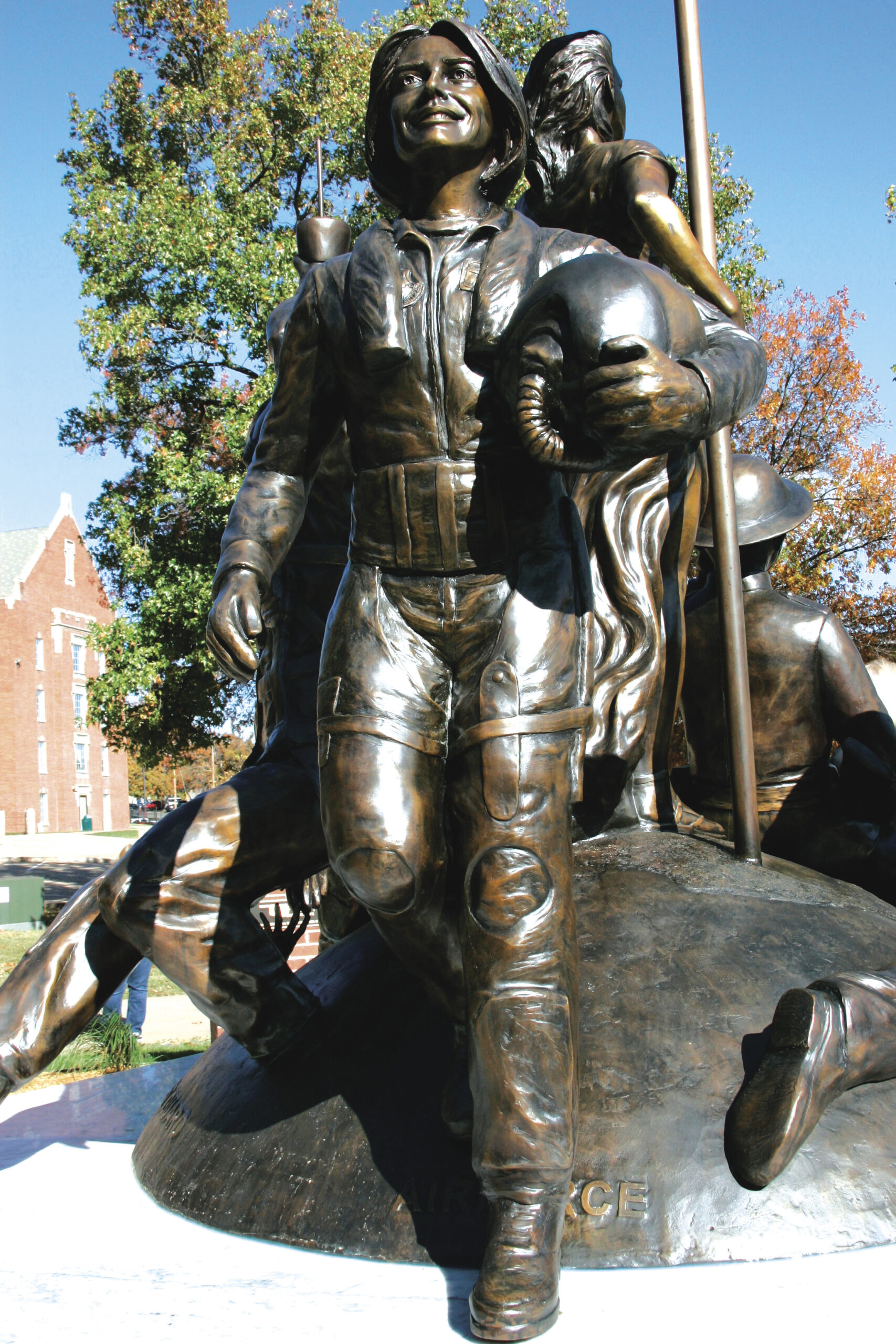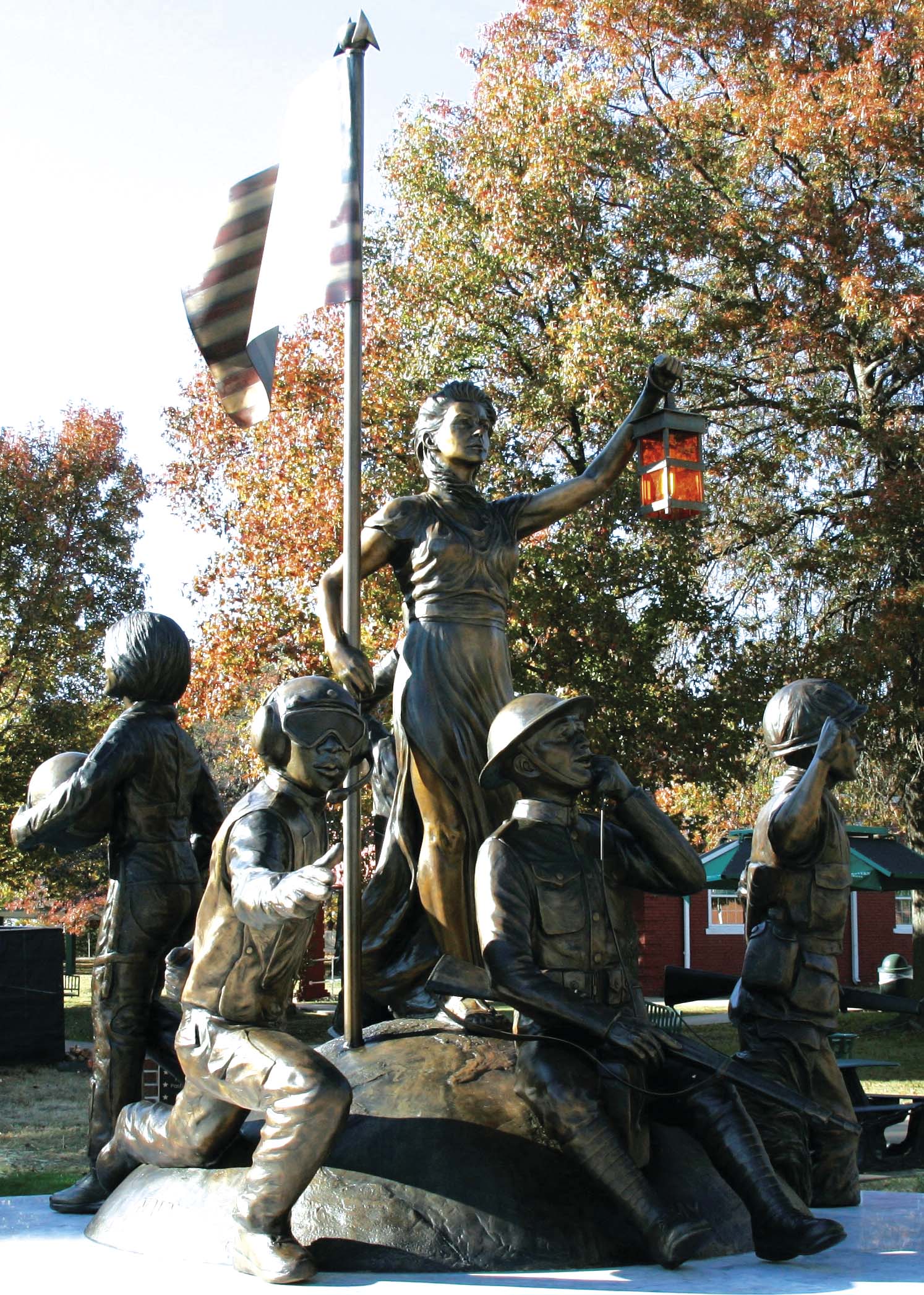
a mission.
In keeping with our new mission to bring Oklahoma veteran news to life, we are only now celebrating the installation and unveiling of the most important military tribute statues ever created by an Oklahoman for Oklahomans. On Veterans Day in 2021, Luther sculptor Joel Randell unveiled his bronze composition, “NSU Veterans: Serving and Communicating through the Decades,” becoming the most visually detailed and robust tribute to military service ever in Oklahoma, located in Tahlequah.
“The complexity of Randell’s tour de force is more than most sculptors will ever achieve in a lifetime if you add up many of their most important military statues,” said former CSU art professor Bob Palmer, Oklahoma’s most viewed muralist. “For one sculptor to bring so many heroic-sized figurative bronzes to life in one setting is the pinnacle of a once-in-a-generation sculpting effort.”

The larger-than-life bronze monument, depicting service members from all branches of the military, graces a plaza on the east side of Seminary Hall on Northeastern State University’s Tahlequah campus.
Two years in the making, following the initial prototype’s approval, the five bronze military figures are a testament to the involvement of many NSU students and community members in support of America’s military mission. The five bronze soldiers representing the military services surround a larger-than-life Lady Liberty, holding a large American flag and a lantern aloft to guide them home.
The Army is depicted by a Cherokee Code Talker from World War I, who sits and provides cryptic communication on the front lines of battle. NSU is the location of the original Cherokee Female Seminary, and Tahlequah remains the capital of the Cherokee Nation.
“We know the Cherokee Nation has a prominent place here in Tahlequah and at NSU. What their soldiers did in World War I was an incredible new effort to help save American lives,” Randell said at the unveiling in 2021. “Many know about World War II Code Talkers, but it was the Cherokee and Choctaw patriots who led that effort initially in their war.”
The Navy is represented by a catapult officer, better known as a “shooter,” who signals when a pilot should take off from a carrier’s flight deck.
A U.S. Marine is seen as a soldier from the Vietnam War wading through a flooded rice paddy while using his hand to signal to fellow soldiers.
The Air Force is depicted by a modern-day female officer pilot holding her flight helmet who successfully completed another mission.
“Incidentally, she would be the highest-ranking person in this composition. She is stepping off the world stage having finished a successful flight, with the satisfaction of a job well done,” Randell said.
The U.S. Coast Guard rescue crewman stretches his arms along a helicopter cable in a heroic effort to save someone in peril at sea.
Elevated in the middle stands a woman who represents the families back home. She is holding a lantern aloft, with a large, colorful American flag billowing in the wind. The lantern has a light feature that emits an amber glow at night.
“Lady Liberty is holding a lantern aloft, effectively shining the way home for those who are scattered abroad. She is standing on a representation I call a semi-globe representation of the Earth,” Randell said. “With her right foot, she is ‘standing’ on Tahlequah so those who see her can remember where home is.”
The two-foot-tall globe at the center of the monument, which all the figures are touching, shows how American veterans have served wherever they were needed around the world. The names of the branches of the services are etched low on the globe behind each service member to help viewers connect with their role in serving.
The artist titled the sculpture “NSU Veterans: Serving and Communicating through the Decades” because each figure uses their body to communicate, whether through a radio, a light, or an arm gesture.
“Lady Liberty’s light is something I’ve never done in a sculpture before. And quite frankly, I don’t know of too many sculptures that go to that length to have an internal lighting system,” Randell said. “It reminds you of a warm fire, and that’s what our service men and women think of, warm thoughts of being back at home.” The innovative lighting system adds a touch of warmth and nostalgia to the sculpture at night, leaving a lasting impression on viewers.
In addition to the flag, the artist placed a triangular logo representing the Space Force, the newest branch of the military, at the top of the flagpole to round out the depiction of American forces.
“I knew that we needed a topper for our flag, right up there,” Randall said. “I looked at the Space Force logo since it is a triangle shape in front of a globe. I think it makes sense at the top. I imagine it in this setting as a communication satellite.”
NSU President Steve Turner praised the monument in 2021, expressing his pride in the new addition to the campus and its proximity to the historic Seminary Hall. “I can’t think of a better place for it to be, adjacent to historic Seminary Hall,” Turner said.
NSU has been recognized as a military-friendly campus. It is also a veteran employer champion and a proud part of the U.S. Department of Defense’s Yellow Ribbon campaign.
It offers comprehensive services for veterans and their families. Resources include a dedicated Office of Veterans Services to assist with educational benefits, a veterans’ lounge, credit for military service, and flexible online learning options. The university helps veterans maximize benefits, complete degrees, and transition to civilian careers.
Randell, 51, is nationally renowned for his patriotic bronze statues, particularly veteran-themed monuments. His prominent works also include the large bronze inclusive Women’s Veterans Monument of similar complexity in Del City, Okla., honoring women service members from each service.
He earned a bachelor’s degree in art education from the University of Central Oklahoma, studying figurative sculpture in bronze with David L. Phelps. After college, he completed his traditional sculpting apprenticeship with Shan Gray.
“The NSU Veterans Monument was a dream come true project,” Randell said recently in an interview. “NSU afforded me a robust budget, allowing me to include all branches of service, various wars and conflicts, while honoring both men and women in a glorious tribute to veterans. At 110 percent life-size, it was heroic size but not overwhelming. With the figures rising from the globe at different points, it is a visual feast from every angle. I am proud this sculpture captures the actions of serving in the military during both peace and war.” • story and photos by Darl DeVault, contributing editor




